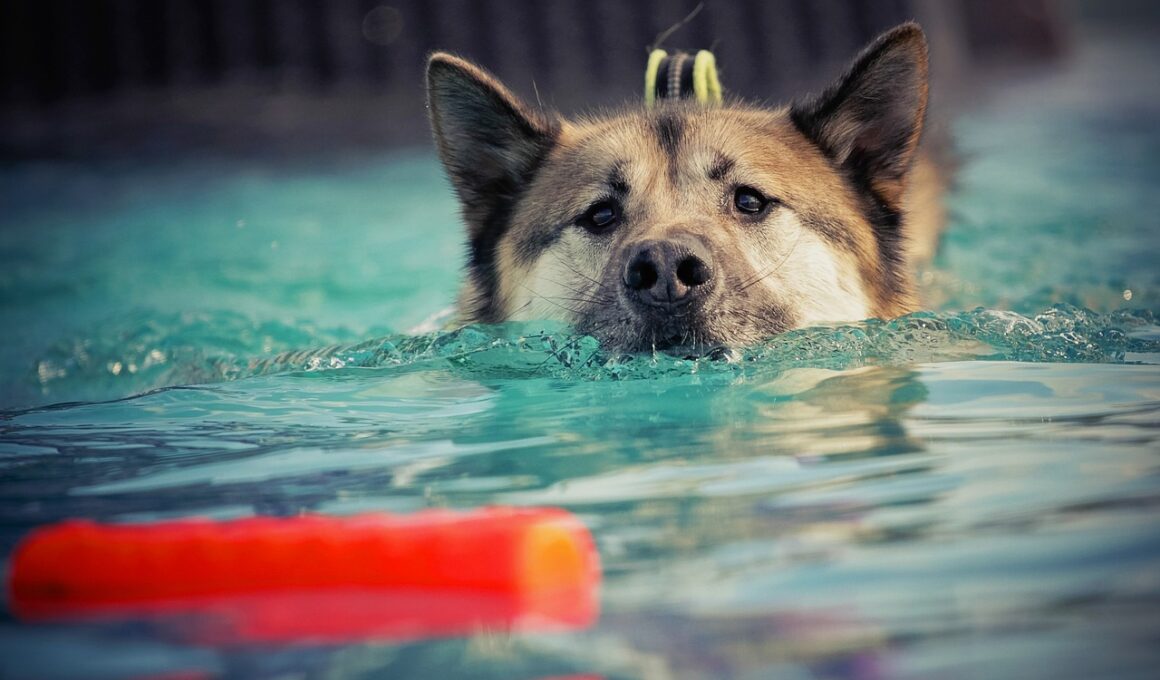How to Motivate Your Dog to Swim More Often
Swimming is a fantastic exercise option for dogs; it builds stamina, improves overall fitness, and is gentle on their joints. Motivation is crucial for ensuring your dog enjoys swimming regularly. Start by introducing swimming in a positive environment. Choose a calm, warm day for your first swim session. Bring along your dog’s favorite toys to create excitement. Floating toys can pique your dog’s interest, prompting them to jump in. Providing reassurance is also vital, especially if your dog seems hesitant. Consider using a life jacket during initial swims to enhance their confidence. Gradually acclimate your dog to the water, allowing them to explore at their own pace. Create fun activities such as playing fetch or swimming training sessions. If possible, arrange playdates with other dogs who enjoy swimming. This can further enhance your dog’s motivation to participate in swimming. Always keep swimming sessions fun and rewarding. Post-swim treats can reinforce the positive experience. Remember, the more enjoyable swimming is, the more likely your dog will be to want to swim regularly.
Choosing the Right Location
Selecting the ideal location for swimming is essential. A calm, clean swimming area that is safe for dogs is paramount. Familiarize your dog with the swimming location before entering the water. Observe how they react to new surroundings. Ensure the water is at a suitable temperature, preferably warm to prevent your dog from getting cold. The swim area should be free from strong currents, sharp objects, and other potential hazards. Nearby shallow areas can also be helpful for hesitant swimmers, as transitioning is easier in safe conditions. If swimming at the beach, keep an eye on tides that can affect your dog’s safety. Shorelines should be clean, with little debris that can cause injury. Look for dog-friendly parks or designated swimming spots for pets. These areas often have other dogs, which can boost your pet’s motivation to swim. Explore local recommendations for dog-friendly swimming spots. You might find a hidden gem that your dog enjoys immensely. Always follow local regulations about dog swimming, ensuring an enjoyable experience for everyone involved while maintaining safety.
Using Positive Reinforcement
Positive reinforcement is one of the most effective techniques for encouraging your dog to swim. Reward your dog with treats or verbal praise every time they enter the water. This creates a mental connection between swimming and positive experiences, making it more likely that your dog will want to swim in the future. Start by rewarding small accomplishments. This can include simply walking toward the water or splashing around. Gradually increase the challenge by requiring your dog to swim gradually further out. Use their favorite snacks to motivate them to chase after floating toys. Verbal praise can be as powerful as treats, letting your dog know they are doing a great job. Ensure to maintain a cheerful tone to elevate their spirits and keep them engaged. By consistently rewarding your dog, you’ll help them associate swimming with fun and excitement. This method builds confidence and fosters a love for swimming over time. Patience is crucial in the process, as every dog is different. Take note of your dog’s preferences, as this will help you tailor rewards and maintain their enthusiasm.
Another great way to enhance your dog’s motivation is through social interactions. Dogs are social animals, and swimming alongside their furry friends can significantly boost their enthusiasm for water activities. Organize playdates with other dogs that enjoy swimming, as it can motivate your dog to join in the fun. Observe how your dog interacts with their friends in the water. They may become more adventurous and enthusiastic if they see their playmates swimming joyfully. Play fetching games in the water to instigate excitement. Involving other dogs naturally encourages a cooperative atmosphere, resulting in ecstatic energy that is hard to resist! If your dog is hesitant, try to stay within reach, offering encouragement. Dogs often draw energy from their companionship, making swimming sessions enjoyable and fulfilling. Explore local dog parks or communities where dog swimming activities occur. Many locations host social events focused on dog swimming. Check social media groups for gatherings where the emphasis is on fun water activities. Building your dog’s confidence with friends can elevate their willingness to swim alone later through joyful experiences.
Ensuring Safety While Swimming
Safety should always be a top priority when your dog is swimming. Start with using appropriate safety gear. A dog life jacket is advisable, particularly for inexperienced swimmers. This provides added buoyancy and helps ensure your dog’s safety while exploring the water. Always monitor your dog when they are swimming. Keep an eye on their energy levels, body language, and whether they appear comfortable swimming. Be aware of potential dangers surrounding your swimming area, like deep waters or strong currents. Having a leash for controlled entry and exit can also help. After a swim, towel off your dog to prevent chills from occurring post-activity. Some breeds are more prone to ear infections after swimming, so be mindful of routine ear cleaning. Also, try to limit swimming sessions to avoid over-exhaustion. Gradual exposure is best—allowing your dog to explore the water step by step ensures safety while helping them build confidence. Don’t hesitate to seek advice from swimming instructors or professionals if you’re unsure about your dog’s swimming capabilities. Safety is always paramount in leisure activities.
Maintaining a Healthy Routine
Consistency is key in regular swimming sessions for your dog. Establish a healthy routine that incorporates swimming as part of your dog’s regular exercise plan. Aim for short sessions several times a week rather than long, infrequent ones. Regular exposure helps your dog become accustomed to swimming, building both confidence and comfort levels. Pair swimming with additional activities, such as land-based exercises or agility training, to help maintain overall fitness. Make sure that activities complement swimming to maintain your dog’s motivation and interest. After swimming, engage in play, combining lighthearted games that allow them to dry off while remaining active. Include interactive toys to keep engagement high on non-swimming days. Consistency is about creating an enjoyable, balanced routine that benefits both you and your dog. Watch for signs indicating your dog’s preferred swimming frequency, and adjust accordingly. Knowing when your furry companion seems eager or hesitant can assist in tailoring sessions for maximum enjoyment. Involving swimming in their daily life can help them embrace a holistic healthy lifestyle that benefits their overall well-being.
Lastly, don’t hesitate to incorporate fun and variety into swimming sessions. Experiment with different activities to spice up the experience for your dog. Try utilizing various toys, such as fetch balls or floating frisbees, which can keep the fun engaging while swimming. Rotating toys can maintain freshness during swimming, ensuring your dog remains interested. Engage in games that require your dog to swim towards you or dash through water obstacles. Mix up wider swimming areas with smaller, deeper pools to develop swimming skills gradually. Introducing new environments can introduce stimulating changes into their aquatic experience. Variety helps keep swimming perceived as enjoyable and fun, preventing it from becoming repetitive or dull. Always observe your dog’s preferences and provide an array of activities that cater to their interests. This fosters a loving relationship with water and maintains their enthusiasm for swimming. Additionally, consider swimming lessons if your dog shows serious interest. Professional guidance can enhance swimming skills and ensure safety. Overall, be sure to encourage those splashes and tail wags that guarantee that your dog has a lasting love affair with water.


